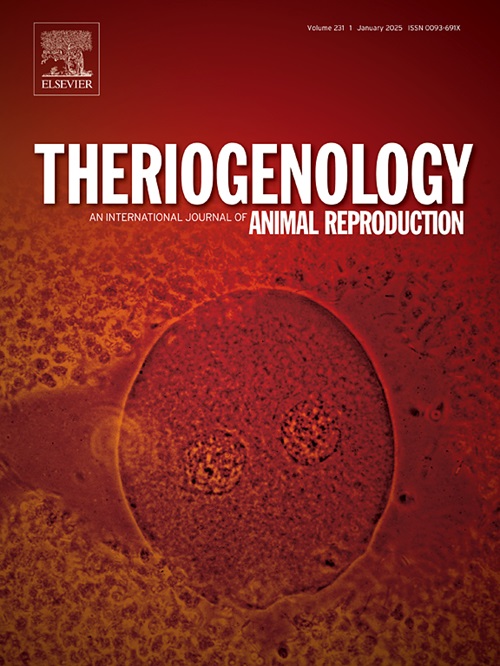Isolation and characterization of extracellular vesicle subsets in donkey seminal plasma
IF 2.4
2区 农林科学
Q3 REPRODUCTIVE BIOLOGY
引用次数: 0
Abstract
Seminal plasma (SP), a fluid composed of secretions from the male genital tract, is rich in seminal extracellular vesicles (sEVs), nano-sized particles surrounded by a lipid bilayer membrane and loaded with functionally active molecules. Seminal EVs are secreted by functional cells of the male genital tract and play a key role in modulating reproductive processes, including sperm function and immune response in the female genital tract. The aim of this study was to isolate and characterize sEVs from donkey SP for the first time. Nine SP samples were collected from nine healthy and reproductive active donkeys. The SP samples were randomly pooled to create three pools (three SP samples per pool). The SP pools were subjected to differential centrifugation and size-exclusion chromatography to separately isolate two subsets of sEVs: small (S-) and large (L-). Orthogonal characterization of sEV samples was performed according to MISEV 2023 guidelines, including morphology (by cryogenic electron microscopy), concentration (by total protein concentration and total and CFSE positive particles by flow cytometry [FC]), particle size distribution (by dynamic light scattering), purity (by albumin assessment by FC), and specific EV protein markers (tetraspanins CD9, CD63, and CD81, and HSP70 by FC). The results showed that donkey SP is highly enriched in sEVs. Size differences were found between both sEV subsets, with S-sEVs being smaller (∼160 nm) and L-sEVs larger (∼290 nm). Both sEV subsets were positive for the four EV protein markers. However, the percentage of CD81-positive events was higher in S-sEV samples than in L-sEV samples (P < 0.05). This study is the first to isolate and characterize sEVs in donkey SP, demonstrating their heterogeneity and suggesting differences in biogenesis and function between S-sEVs and L-sEVs.
驴精浆细胞外囊泡亚群的分离与鉴定
精液(SP)是一种由男性生殖道分泌物组成的液体,富含精液细胞外囊泡(sev),这些纳米级颗粒被脂质双层膜包围,并装载有功能活性分子。精液EVs由男性生殖道的功能细胞分泌,在调节生殖过程中发挥关键作用,包括精子功能和女性生殖道的免疫反应。本研究的目的是首次从驴SP中分离和鉴定sev。从9头健康、繁殖活跃的毛驴身上采集9份SP样品。SP样本随机分成3个池(每个池3个SP样本)。对SP池进行差速离心和排粒径层析,分别分离出小(S-)和大(L-)两个sev亚群。根据MISEV 2023指南对sEV样品进行正交表征,包括形态学(通过低温电子显微镜)、浓度(通过流式细胞仪[FC]通过总蛋白浓度、总和CFSE阳性颗粒)、粒径分布(通过动态光散射)、纯度(通过FC评估白蛋白)和特异性EV蛋白标记物(四跨蛋白CD9、CD63和CD81,以及HSP70)。结果表明,驴SP在sev中高度富集。两种sEV亚型之间存在尺寸差异,s -sEV较小(~ 160 nm), l -sEV较大(~ 290 nm)。两个sEV亚群的四种EV蛋白标记物均呈阳性。然而,S-sEV样本中cd81阳性事件的百分比高于L-sEV样本(P <;0.05)。本研究首次在驴SP中分离和表征了sev,证明了它们的异质性,并表明s - sev和l - sev在生物发生和功能上存在差异。
本文章由计算机程序翻译,如有差异,请以英文原文为准。
求助全文
约1分钟内获得全文
求助全文
来源期刊

Theriogenology
农林科学-生殖生物学
CiteScore
5.50
自引率
14.30%
发文量
387
审稿时长
72 days
期刊介绍:
Theriogenology provides an international forum for researchers, clinicians, and industry professionals in animal reproductive biology. This acclaimed journal publishes articles on a wide range of topics in reproductive and developmental biology, of domestic mammal, avian, and aquatic species as well as wild species which are the object of veterinary care in research or conservation programs.
 求助内容:
求助内容: 应助结果提醒方式:
应助结果提醒方式:


